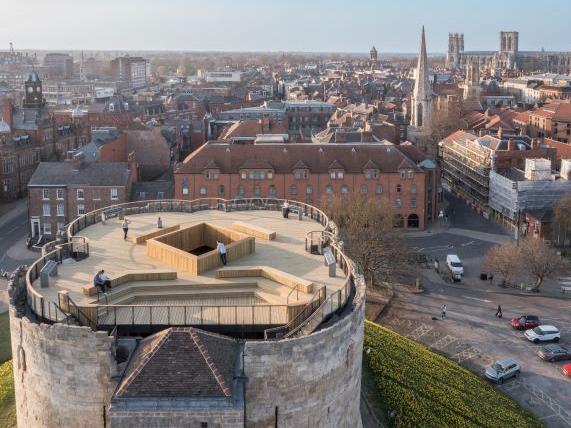English Heritage reopens Clifford’s Tower in York to the public in April, following a major £5m project to conserve and radically transform the interior of the 800-year-old landmark.

Where previously the tower was an empty shell, the charity has now installed a free-standing timber structure within it, protecting the ruin and creating a new roof deck to provide views over York. On the tower’s lost first floor, dramatic aerial walkways open up hidden rooms for the first time since Clifford’s Tower was gutted by fire in 1684.
“At Clifford’s Tower, new architecture is transforming a centuries-old landmark, opening it up and unlocking its secrets. We’re protecting Clifford’s Tower for future generations and inspiring more people to discover its stories,” said Kate Mavor, chief executive of English Heritage.
Clifford’s Tower is almost all that remains of York Castle, which was the centre of government for the North throughout the Middle Ages and up to the 17th-century - the place where the whole of the North of England was ruled from.
Staircases and hanging walkways combine to take visitors 10 metres up to a new roof deck from where they can enjoy the York skyline. Enroute to the top, visitors will be brought face to face with the tower’s fascinating architectural details and can explore a royal chapel and – for the first time since the 17th century – a toilet built especially for Henry III.
The new interior and roof deck at Clifford’s Tower has been designed by Hugh Broughton Architects. Supported by four slender wooden columns, the structure sits on a raft foundation, which spreads the load without impacting on the archaeological remains beneath the tower. The practice worked closely with conservation specialists Martin Ashley Architects to produce a scheme which sits respectfully within the heritage structure.
New interpretation will help place the tower in the context of both the historic York Castle and the city of York itself as well as introducing visitors to the tower’s long and turbulent history. Visitors can explore the castle’s founding by William the Conqueror, the tower’s role as the site of the tragic 1190 massacre and suicide of York’s Jewish community and the role of the castle as both a medieval royal stronghold and a garrison during the Civil War.
Layers of background sound will take visitors back in time, allowing them to experience the tower as it would have been at various periods in its history.
As part of the English Heritage project, the tower has also been conserved. Exposed to the elements for more than 300 years, its historically fire damaged stonework, and the walls, turret stairs, arrow slits and fireplaces have been repaired. The chapel has been reroofed, while the carved heraldic plaques above the entrance to Clifford’s Tower, showing the coats of arms of Charles I and Henry Clifford, Earl of Cumberland, have also been conserved.